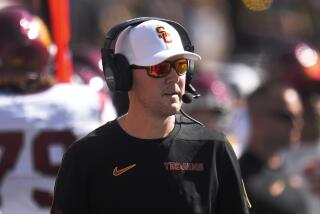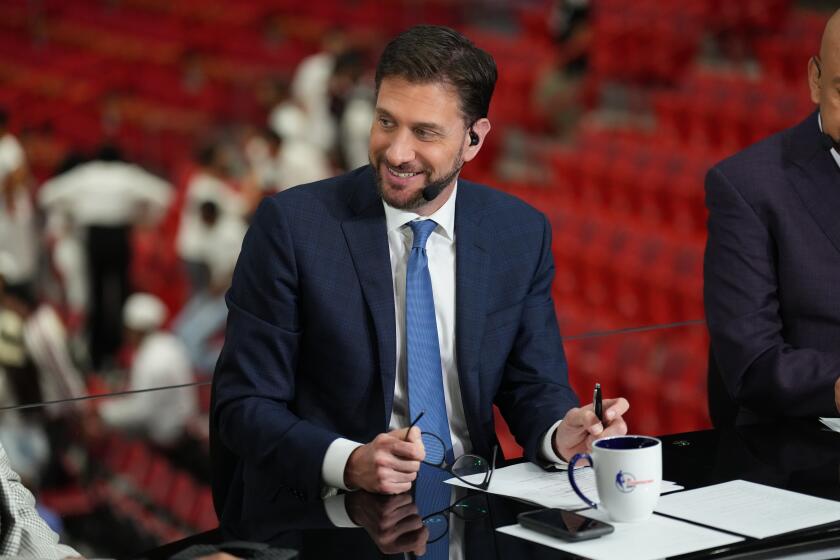His Wife Is No Quitter, so Neither Is Sloan
Jerry Sloan has been coaching for so many years and been asked about it so many times he has stock reasons to explain why he has the longest tenure of any head coach in American pro sports.
“The players haven’t run me off,” he says.
“Our ownership has given me the opportunity to coach the team and stuck behind us when things haven’t gone very well.”
In reality, there’s only one reason Sloan, 61, continues to coach the Utah Jazz for a 16th consecutive season: His wife won’t let him quit.
He has been married to Bobbye, his high school sweetheart, for four decades. She is the mother of his three children and together they have shared the joy of seven grandchildren.
On Jan. 6, Jerry told Utah reporters that Bobbye, 60, had a biopsy.
In a quiet moment in the locker room of his new team that night, Karl Malone, a cornerstone of Jerry Sloan’s Jazz teams for 18 seasons, predicted that if the biopsy results were bad Jerry would quit to be with his wife.
The news was beyond bad. Bobbye had a malignant tumor in her pancreas. One Jazz official said Jerry was prepared to leave.
Only it wasn’t his decision.
“He’s going to go on with his job whether he wants to or not,” Bobbye said at a news conference Jan. 8. “My biggest pleasure has been watching this wonderful team that everyone put together, and you’re not going to take that away from me.”
So Sloan, who’s so good at getting grown men to do what he wants, followed orders. And he continued to do what he has done as well as anyone in the business: coach basketball.
“I don’t know anything else,” he says.
Well, he does know about farming. He and Bobbye spend the off-season in their hometown of Mcleansboro, Ill., where they have 1,000 acres of land that Jerry patrols on his tractor, tending to the wheat, soybeans and corn.
But he looked around the farm last summer, realized that all of his friends were busy tending to their own business and decided he’d better get back to his.
So he returned this season even though Malone left to join the Lakers, John Stockton retired and the Jazz couldn’t land any of the big free agents it went after.
“Our job still remains the same,” Sloan said. “I’ve said this all along, even a few years ago. People always wondered what it’s going to be like losing John and Karl. Well, our job doesn’t change. When we lost Shandon Anderson and Jeff Hornacek, we hated to lose them because they were good for us and they helped our team, but we still had to go out there and play.”
That’s always been his mentality. There’s a game scheduled, so get out there and compete.
Malone’s tough-guy approach, the one that enabled him to have only four games missed due to injury in his career before the sprained knee ligament that has sidelined him since December, came from Sloan.
“I just got the no-nonsense, put your boots on tightly, lace ‘em up tight, no excuses and go out and play [attitude],” Malone said. “That’s what I got from Coach. There’s no doubt about that.”
If it were all about lessons in toughness, the Jazz could have brought in Clint Eastwood to run the show. Sloan knows his Xs and O’s, and knows how to get his players to take the concepts from the drawing board to the court.
His teams have always been known for their meticulous execution. That’s why it should have come as no surprise that his Jazz started the season well even with a bunch of players you’ve never heard of, a group whose only distinguishing characteristic was Andrei Kirilenko’s Flock of Seagulls-style hairdo.
Utah won 11 of its first 18 games and stayed competitive in the Midwest Division, the toughest in the NBA.
Maybe the Jazz doesn’t rely on the pick-and-roll as often as in the Stockton-to-Malone days, but its discipline is still admired by coaches around the league. The Jazz makes opponents work on defense for all 24 seconds on the shot clock and makes opponents keep playing for all 48 minutes of the game.
The Lakers know. They had to hold on for a two-point win after leading by 21 at Staples Center on Dec. 7, and they had to sweat out a 93-86 victory after leading by 19 here Saturday night.
“We have to play in some semblance of order,” Sloan said. “We’re not talented enough to try to go out there and win on our own.
“Learn the disadvantage of a quick shot over a later shot, [the advantage of] an inside shot over an outside shot. A number of things guys can learn that helps give them a chance to be able to compete a little bit. If they aren’t strong enough to defend one-on-one, then you’d better be able to take decent shots so you can defend the other end of the floor.
“It’s just basketball.”
And straight-up good coaching.
But no one can do it without good players. The Jazz hasn’t had Keon Clark (bone spur, right ankle) since Nov. 8, lost Matt Harpring to season-ending knee surgery this month and has missed Kirilenko (sprained right ankle) the past four games and has lost five in a row to drop below .500
Sloan won’t let his players feel sorry for themselves. In typical fashion he called them out last week, wondering who among them had the will to compete.
Phil Jackson can relate to Sloan’s injury-riddled squad. And he also knows what it’s like for coaches who get overlooked when they have a talented roster.
“As a coach you have to be really willful, and yet you have to be able to do it in a way that keeps your players hustling and interested and not self-defeated and despairing,” Jackson said. “He’s done that. His longevity’s said something about that, and his ability to coach a variety of ways has also said that about his game and the way he coaches.”
Sloan is four victories shy of 900, but if the Jazz can’t make the playoffs he might go another season without a coach-of-the-year award.
Not that he cares.
“He’s a tough guy,” said Hot Rod Hundley, Utah’s play-by-play announcer and Sloan’s close friend. “He’s going through a lot, but he keeps it inside. I don’t see any changes in his coaching, in his approach to the game. He’s still good.”
Still, Bobbye’s life-threatening illness brings out a rarely seen side of Sloan. He choked back tears at the Jan. 8 news conference and needed Bobbye’s gentle touch on his hands to get through it. He had to end a recent radio interview when Bobbye’s health was mentioned.
It only came up this time after the recorder was clicked off, when all a reporter could offer was best wishes to his wife. Sloan said thanks and his eyes began misting.
“Tough row to hoe,” he said.
Still the farmer -- the coach -- continues on.
*
J.A. Adande can be reached at j.a.adande@latimes.com. To read more columns by Adande go to latimes.com/Adande.
More to Read
Go beyond the scoreboard
Get the latest on L.A.'s teams in the daily Sports Report newsletter.
You may occasionally receive promotional content from the Los Angeles Times.










